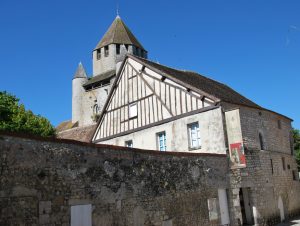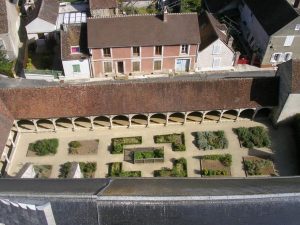Great novelty in Provins!
Discover the thousand-year-old historical site of the Saint-Ayoul Priory, thanks to an audio-guided visit!

15 years!
15 years is the time it took to restore the Priory Saint-Ayoul, acquired by the town of Provins in 2003.
It is located in the centre of Provins, next to the church of the same name.
Building, fire, rebuilding, demolition, restoration, the Saint-Ayoul Priory has known several lives and a history worthy of the greatest novels!
The origins of this architectural ensemble date back to 996…
It all began with the discovery of relics attributed to Saint Ayoul. They were immediately put under cover and preserved in the crypt of the Saint-Médard chapel, built for this purpose.
Bringing to light the remains of a saint or martyr was at that very religious time, an immense event and synonymous of consequent pilgrimage.
Indeed, in the middle of the 11th century, Count Thibaut I of Champagne decided to reform the place. The chapel became too small to accommodate the increasing number of pilgrims who came to pray.
It gave way to a more extensive project: a parish church and a priory of the Benedictines, religious of the Order of Saint Benedict.
The church was built according to a particularly ambitious plan, with a nave with aisles, a vast transept, and an ambulatory choir with several radiating chapels.
Over the centuries, the whole has been constantly reworked: destruction, rebuilding, extensions, etc. (see the complete history at the end of the page (only in French).


The year 1527 marked a turning point following an ancient conflict between the two religious communities, parish and priory: the monument was definitively separated into two distinct parts. The nave and the aisles were attributed to the parish, while the chevet remained to the priory. A wall was built between the two parts.
Sold as a national property at the end of the 18th century, it was used by the sub-prefecture, the national gendarmerie, the Cavalry (imagine the chevet transformed into a barn for horse fodder), and the army.
Part of it was even bought back by private individuals who transformed it into a dwelling and outbuilding, and demolished chapels to erect walls to separate the properties.
From 1938, the chevet was retroceded by the War Ministry to the Fine Arts Department.
Afterwards, came the first works and first acknowledgments of the monument. The main modern openings were closed and some old bays were reopened. It was the beginning of archaeological excavations, studies, and consolidation work.
Since 2003, therefore, efforts have never stopped. They consisted in excavations and discoveries, classification as a Historic Monument, rehabilitation and restoration.
The result is sublime and captivating. Magnificent frescoes and painted plaster have been revealed at the transept crossing and on the walls, proof that the religious buildings used to be coloured and decorated with motifs of religious symbols.




An architecture out of the ordinary
The entrance is through the porch on the right side of the Saint-Ayoul church, more precisely at n°1 de la cour des Bénédictins.
- the medieval plant garden (yews, sedums and saskatoons),
- the cloister and its panoramic view over the ancient medieval gallery sites,
- the capitular hall with its perfectly preserved architecture and the south chapel,
- the chapel of the Benedictines or « choir of the monks » (large off-centre apse completed around 1280),
- In the finally reopened windows, all the stained-glass windows were entrusted to the artist Udo Zembok. Their colours and diversity complete the reading of the monument and relay the sculptures made on the church portal by the French artist Georges Jeanclos, between 1985 and 1988,



- the transept,
- the radiant chapels,
- at the level of the north arm of the transept, don’t fail to appreciate the extraordinary stacking of ground levels from the 11th to the 20th century!


Small and great History
• What is the difference between a parish church and a Benedictine priory?
The parish church is a place of cult, assigned to a parish priest, under the authority of the Bishop. The Benedictine priory as mentioned above is governed by the rule of St. Benedict. Rather strict, it obeys its own regulations. The priory is a real place of life, reserved for religious men and women where they can sleep, eat, exchange, and above all pray.
• It is said that the Fairs of Champagne started thanks to the pilgrimage.
Such a large crowd necessarily has needs (food and other goods). It was not uncommon, and still today, to see merchants setting up their stalls. This configuration would have given the Counts of Provins the idea of creating large commercial gatherings twice a year: in May in the upper town around the Place du Châtel, and in November in the lower town, in the Saint-Ayoul district.


• The chapter hall was the main place of life: reading of a chapter of the Rule of St Benedict every morning, deliberation of temporal affairs, distribution of the daily tasks, reading of news from other abbeys, election of abbots, public confession of faults between monks.
Not all of them had the privilege of taking part in the discussions or of intervening, but all of them attended.
• A space dedicated to our Chinese twin city Pingyao
In 2005, the city of Pingyao in China and the city of Provins, two medieval cities listed as UNESCO World Heritage Sites, decided to become sister city. This aims to strengthen understanding and friendship between peoples and to consolidate and develop friendly ties between the two cities. « Tourism and Heritage Spaces » have been inaugurated in each of the two cities, for a dynamic reciprocity.
This space was inaugurated in 2016, in the presence of the Chinese authorities.
• A space and an exhibition dedicated to the citadel of Thang Long in Vietnam: as part of the partnership between Provins and the city of Hanoi and the 20th anniversary of Provins’ inscription on the World Heritage List!




Schedules & Welcome conditions
Information and welcome conditions subject to change.
Schedules:
– Audio-guided visit in English, Chinese and French:
• Up to 28 March 2025: weekends, public holidays and daily during French school holidays (zones B & C) from 2 p.m. to 5 p.m.
• From 29 March to 31 August: daily from 10 a.m. to 6 p.m.
• From 1 September to 2 November: weekends, public holidays and extra day from 10 a.m. to 6 p.m. – week from 2 p.m. to 6 p.m.
• From 3 November 2025 to 4 January 2026: weekends, public holidays and daily during French school holidays from 2 p.m. to 5 p.m.
• Annual closure: 1 January and 25 December.
Prices:
Included in the Pass Provins
Ticket for the monument only: adult 5 € – child (4-12 year old) 3 € – free for 4 of age and under.
Length: about 45 min.
Last admission 15 min. before the closure of the monument.
Audio-guided visit: in exchange for identity papers.
Please note that animal friends are not allowed in the monuments, nor on the sites of the shows, nor in the major events.
Buy your tickets online or on site
• Ticket for the monument only: adult 5 € – child (4-12 years old) 3 € – free for under 4 years old.
• The Saint-Ayoul Priory is included in the Pass Provins, from 9,50 €.
Once the date has been chosen, the 10.00 a.m. or 2.00 p.m. times (according to the season) that appear simply correspond to the opening time of the monument.
Your ticket is valid for the whole day or half-day.












